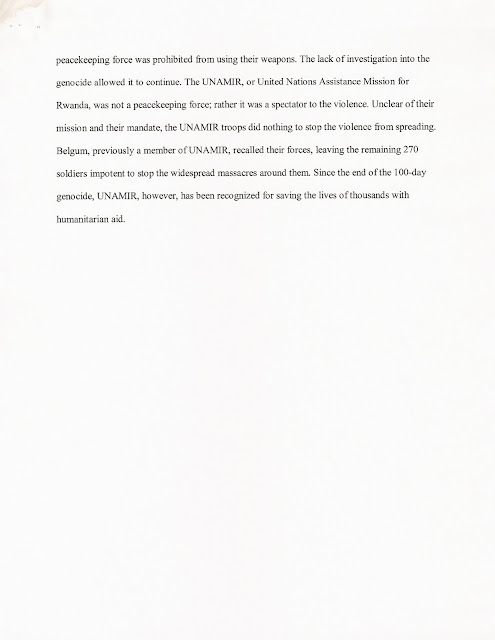Eliyahu N. Kassorla
Global Social Problems
C. Dale, Ph.D.
Understanding Rwanda
It is a sad fact that the majority of people believe that the last of the genocides ended in 1948. World War II had concluded and the Nuremberg Trials reflected our evolution into a more evolved species. It is therefore no great surprise that the world was inactive when, in 1994, the Rwandan government began to systematically target and destroy the Tutsi.
In Rwanda, there are two primary ethnic groups: the Hutu and the Tutsi. The first tensions were laid down in 1990, when the Tutsi invaded Rwanda from Uganda, under the auspices of the Rwandan Patriotic Front (RPF) (Novogratz, 148). This group was composed of the displaced Tutsi of a previous attempt to exterminate the Tutsi. The government of Rwanda, dominated by the Hutu, attempted to fight back, but had not achieved a decisive victory against the RPF. “This marked the beginning of fear. And with fear began the disinformation campaigns, the lying, and the manipulation by Rwanda’s leaders to instill even more defensiveness–and paranoia […] For the next five years, the questions would be asked [… a]re you a Hutu or a Tutsi?” (Novogratz, 149).
In 1994, the plane of Rwandan president Habyarimana, with Burundi president Ntaryamina – a Hutu – onboard, was shot down outside Kigali International Airport. The government both attributed the attack to the Tutsi, and began to speak openly about extermination of the Tutsi. Almost immediately, the already strained Arusha Accords were, in effect, nullified, and the RPF stationed in Kigali were fired upon. “All across the country, government officials were whipping up the populace with a paranoid torrent of words [, …] the message was consistent: The Tutsis had invaded Rwanda to regain power and subjugate the Hutus. [… O]rdinary Rwandan citizens resorted to murdering their neighbours, cheered on by local authorities” (Novogratz 150).
The Interhamwe, along with the Impuzamugambi, were two violent militia groups. They were responsible for most of the violence in the Rwandan genocide. Both groups included youth wings, employing child soldiers to commit grave atrocities to human life. The Interhamwe and Impuzamugambi organized marches on the street declaring the Tutsi “inyeni,” or cockroaches, to galvanize support for their agenda of wanton murder. There is no question that support for these groups came directly from the Rwandan government. Both the government and these groups adopted the idea that both the Tutsi and moderate Hutus, including those who refused to participate in the slaughter of the Tutsi, must die. “The government’s grand plan was to ensure the collective guilt of every Rwandan, while exterminating every single Tutsi and moderate Hutu” (Novogratz, 151).
The government of France cannot be held blameless. Rwanda was a French colony, and Uganda a British colony. When the RPF crossed the border from Uganda, the French supported the Hutus against what they believed to be was an English plot to disrupt French influence. Further, many crimes of murder and rape occurred in the French held areas in Zaire. Further, France continued arms shipments in to Rwanda before the genocide, in violation of the Arusha Accords, arming the Hutus to the teeth.
The government of the United States, bogged down in bureaucracy, was also slow to react. Though the genocide began in April, government officials would not use the term genocide until May.
The United Nations is also a major actor who shares the fault. Their unbelievably slow response to the killings is a major reason that the genocide continued. Despite a UN presence, the peacekeeping force was prohibited from using their weapons. The lack of investigation into the genocide allowed it to continue. The UNAMIR, or United Nations Assistance Mission for Rwanda, was not a peacekeeping force; rather it was a spectator to the violence. Unclear of their mission and their mandate, the UNAMIR troops did nothing to stop the violence from spreading. Belgum, previously a member of UNAMIR, recalled their forces, leaving the remaining 270 soldiers impotent to stop the widespread massacres around them. Since the end of the 100-day genocide, UNAMIR, however, has been recognized for saving the lives of thousands with humanitarian aid.



No comments:
Post a Comment